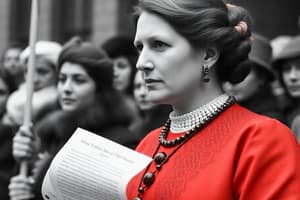Podcast
Questions and Answers
Which of the following describes the significance of Angelina and Sarah Grimke in the context of the 19th-century suffrage movement?
Which of the following describes the significance of Angelina and Sarah Grimke in the context of the 19th-century suffrage movement?
- They are more known for their involvement in the temperance movement.
- They were actively involved in organizing conventions and political campaigns.
- They primarily focused on writing pamphlets and articles advocating for women's rights without engaging in public speaking.
- They served as early role models for women in public speaking, particularly during the 1830s. (correct)
What was the main purpose of the convention advertised in the local paper, as mentioned in the text?
What was the main purpose of the convention advertised in the local paper, as mentioned in the text?
- To explore the social, civil, religious conditions, and rights of women. (correct)
- To organize protests and demonstrations against discriminatory laws.
- To promote educational opportunities.
- To discuss strategies for achieving women's right to vote through political lobbying.
Besides Lucretia Mott, who else partnered in the effort to progress the suffrage movement with Elizabeth Cady Stanton?
Besides Lucretia Mott, who else partnered in the effort to progress the suffrage movement with Elizabeth Cady Stanton?
- Susan B. Anthony (correct)
- Sojourner Truth
- Frances Willard
- Abby Kelly Foster
What aspect of the suffrage movement did Elizabeth Cady Stanton primarily contribute to?
What aspect of the suffrage movement did Elizabeth Cady Stanton primarily contribute to?
What was Frances Willard's primary contribution to social reform in the late 19th century?
What was Frances Willard's primary contribution to social reform in the late 19th century?
Which amendment did the NWSA primarily focus on and remain committed to?
Which amendment did the NWSA primarily focus on and remain committed to?
What action did Isabella Beecher Hooker take in 1871 in relation to the suffrage movement?
What action did Isabella Beecher Hooker take in 1871 in relation to the suffrage movement?
What event took place in 1890 regarding the NWSA and AWSA?
What event took place in 1890 regarding the NWSA and AWSA?
Flashcards
Angelina & Sarah Grimke
Angelina & Sarah Grimke
Pioneering women who advocated for women's rights and abolition in the 1830s.
Seneca Falls Convention
Seneca Falls Convention
The first women's rights convention held in 1848, organized by Lucretia Mott and Elizabeth Cady Stanton.
Declaration of Sentiments
Declaration of Sentiments
A document outlining the rights women should be entitled to, drafted during the Seneca Falls Convention.
Lucretia Mott
Lucretia Mott
Signup and view all the flashcards
Frances Willard
Frances Willard
Signup and view all the flashcards
National Woman Suffrage Association (NWSA)
National Woman Suffrage Association (NWSA)
Signup and view all the flashcards
American Woman Suffrage Association (AWSA)
American Woman Suffrage Association (AWSA)
Signup and view all the flashcards
Sojourner Truth
Sojourner Truth
Signup and view all the flashcards
Study Notes
19th Century Suffrage
- Angelina and Sarah Grimké modeled public speaking for women in the 1830s.
- Women's conventions addressed social, civil, and religious issues, along with women's rights.
- Lucretia Mott and Sojourner Truth collaborated.
- Abby Kelley Foster's speeches influenced Frances Willard, who supported the temperance movement.
- Elizabeth Cady Stanton and Susan B. Anthony partnered in 1851 to advocate for women's suffrage.
- Susan B. Anthony was a speaker and organizer.
- Lucy Stone also supported women's suffrage, notably the 15th and 19th Amendments.
- Mary Ann Shadd Cary collaborated with Elizabeth Cady Stanton in the 1860s.
- In 1878, Mary Ann Shadd Cary linked women's suffrage to the political action of parties.
- The 1865 formation of the AERA (American Equal Rights Association) and the declaration were influenced by Pillsbury,
- Elizabeth Cady Stanton supported the 19th amendment. Isabella Beecher Hooker worked to unite different women's suffrage groups.
- Matilda Joslyn Gage was also a significant figure in the formation of the NWSA.
- The National Woman Suffrage Association (NWSA) and American Woman Suffrage Association (AWSA) documented women's suffrage history up to 1885.
Studying That Suits You
Use AI to generate personalized quizzes and flashcards to suit your learning preferences.




